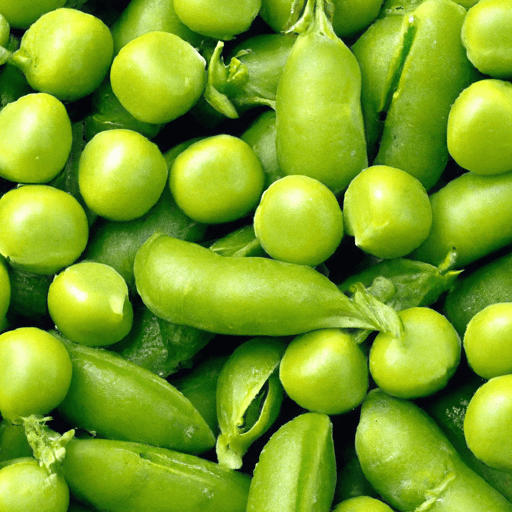The Delightful World of Baby Peas: A Tiny Burst of Flavor!
If you’re a fan of peas, then you’re in for a treat. Today, we’re diving into the delightful world of baby peas - those pint-sized versions of the humble green vegetable that are packed with flavor and nutrition.
Taste Explosion in Every Bite!
Baby peas, also known as petit pois, may be small in size, but they certainly make up for it in taste! These tiny green spheres are bursting with sweetness and have a slightly more delicate flavor compared to their full-sized counterparts.
When cooked just right, baby peas have a tender yet firm texture that provides a satisfying bite. Their natural sweetness shines through, making them a delightful addition to any dish.
Versatile in the Kitchen
Baby peas are incredibly versatile and can be used in a wide range of dishes. They are a staple in many cuisines and can be enjoyed both as a side dish and as a key ingredient in various recipes.
One classic way to showcase the beauty of baby peas is in a simple pea purée. By blending steamed peas with a touch of mint, lemon juice, and a drizzle of olive oil, you can create a vibrant and refreshing dip or sauce that pairs perfectly with grilled meats or as a spread for crostini.
If you’re in the mood for a light yet satisfying salad, baby peas are a fantastic addition. Toss them with fresh greens, crumbled feta cheese, and a tangy vinaigrette for a refreshing and nutritious meal.
These petite green gems also play well with other vegetables. Consider combining them with carrots, pearl onions, and baby potatoes to create a delightful medley of flavors and textures. Whether it’s stir-frying, steaming, or sautéing, baby peas bring vibrancy to any dish.
Nutritional Powerhouse
Don’t let their small size fool you – baby peas pack quite the nutritional punch! These little green powerhouses are low in fat, cholesterol-free, and a great source of essential vitamins and minerals.
First and foremost, baby peas are an excellent source of dietary fiber, which aids in digestion and promotes a healthy gut. They’re also rich in vitamin C, an antioxidant that supports a strong immune system, as well as vitamin K, which plays a role in blood clotting and bone health.
Additionally, baby peas contain folate, a B-vitamin that is crucial for proper cell division and the healthy development of unborn babies. This makes them an ideal choice for expectant mothers.
Fun Facts and History
Did you know that peas have a long and fascinating history? Dating back thousands of years, peas were first cultivated in the Mediterranean region and later spread throughout Europe and Asia. They were one of the earliest crops cultivated by humans and have been enjoyed as a food source for centuries.
In the 17th century, a French gardener named Nicolas Appert developed a method for canning young peas. This contribution revolutionized the preservation of peas and made them available year-round, regardless of the growing season.
Baby peas hold a special place in many culinary traditions. In French cuisine, they are considered a delicacy and are often featured in dishes such as Poultry a la Bonne Femme and Ratatouille. In Indian cuisine, baby peas are commonly used in curries and rice dishes, adding a touch of sweetness and vibrancy to the final creation.
Conclusion
Baby peas, those tiny orbs of sweetness, are a true delight in the culinary world. Whether you’re steaming, sautéing, or blending them into a creamy dip, their natural flavor and nutritional benefits make them a worthwhile addition to any dish. So why not give these petite powerhouses a try and experience their taste explosion for yourself? Your taste buds will thank you!
Interesting Facts about Baby Peas:
Origin and Common Uses:
- Baby peas, also known as sweet peas or garden peas, are a variety of green peas harvested at an early stage of maturity.
- Green peas have been cultivated since ancient times, believed to have originated in the Mediterranean region and Western Asia. They have since been grown globally.
- Baby peas are commonly used in a wide range of cuisines worldwide, including soups, stews, salads, stir-fries, and as a side dish.
Nutritional Benefits:
- Baby peas are a good source of vitamins and minerals. They contain vitamins A, C, and K, as well as folate, thiamine (vitamin B1), and vitamin B6.
- They are also a good source of dietary fiber, which aids in digestion and helps maintain bowel regularity.
- Baby peas are relatively low in calories but offer a decent amount of protein and carbohydrates, providing a well-rounded nutritional profile.
Unique Properties:
- Baby peas are known for their vibrant green color and delicate, sweet flavor.
- Unlike mature peas, their thin skin is edible and tender, requiring minimal cooking time.
- Due to their small size and tenderness, baby peas are often eaten whole, providing a pleasing pop and crunch when consumed.
- These peas are commonly sold frozen, which helps preserve their taste, texture, and nutritional value.
Historical Significance:
- Peas have a long history and have been an important food source for thousands of years.
- In Western cultures, peas gained popularity in the 16th and 17th centuries. The French King Louis XIV was particularly fond of peas and famously encouraged their cultivation in France.
- In the 18th century, the cultivation of sweet peas gained popularity, with new varieties specially bred for their sweet flavor.
- Sweet peas became a symbol of luxury and refinement during the Victorian era, leading to the development of various cultivars with diverse color patterns and aromatic qualities.
These are some interesting facts about baby peas, including their origin, common uses, nutritional benefits, unique properties, and historical significance.




Use the share button below if you liked it.
It makes me smile, when I see it.